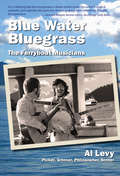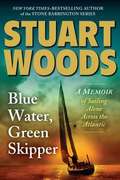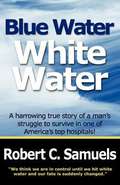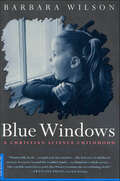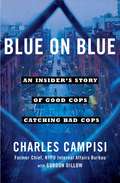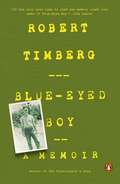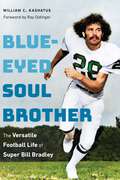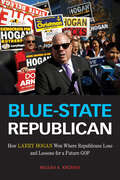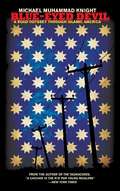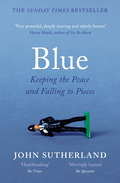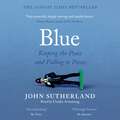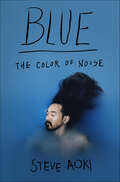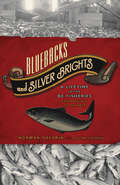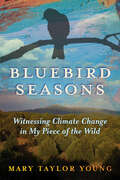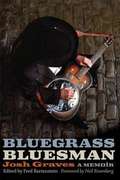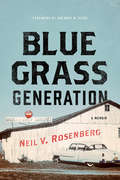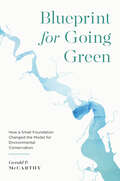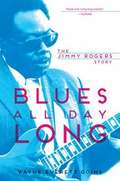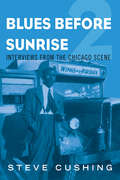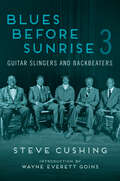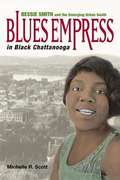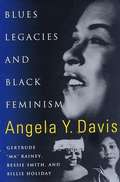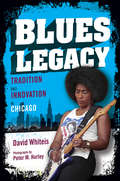- Table View
- List View
Blue Water Bluegrass: The Ferryboat Muscians
by Al LevyThis is a story of a magical time and place that was very real. Magic is the power to transform. See for yourself how a couple of young men transformed an ordinary ferry ride into Ferryboat Music. Their music touched and changed the lives of thousands who saw them every weekend on the sparkling waters of Puget Sound. This is a story of transforming fear into love, mundane into miraculous, and isolation into connection. Feel the heart and the humor in every story in these pages.
Blue Water, Green Skipper: A Memoir of Sailing Alone Across the Atlantic
by Stuart Woods Stephen CollinsStuart Woods had never owned more than a dinghy before setting out on one of the world's most demanding sea voyages, navigating single-handedly across the Atlantic. How, at the age of thirty-seven, did this self-proclaimed novice go from small ponds to the big sea?<P> Now with a new afterword that looks back at how one transatlantic race changed his life, Woods takes readers on a spectacular journey not just of traveling across the world, but of being tried in fire, learning by accepting challenges, appreciating the beauty of the open water, and living to tell about it.
Blue Water, White Water
by Robert C. SamuelsWithout self-pity, former New York City newspaperman and prize-winning magazine editor, Robert C. Samuels tells his own harrowing story of medical survival. He's filled it with tears, humor, love and triumph. "Audacious, brilliantly written, Blue Water, White Water, is a rare, first-person look at a world that is often closed to the average person. It is well worth your time," raves an early critic. "A riveting, vivid story!" Jan Dye Gussow, author of Growing Older: A Chronicle of Death, Life, and Vegetables. "Producers will pounce. This book IS a movie!" Carolyn Fox, Entertainment News Calendar. "Should be required reading for all medical and nursing students! A must read!" Nursing Professor Barbara Riso, R.N. "Wow! Written with an amazing ability to portray a true, horrific story that keeps readers glued to the page and laughing at the same time," Peggy Whalen, R.N. "A powerful description of genuine helplessness," Tyler Lucas, M.D.
Blue Windows: A Christian Science Childhood
by Barbara WilsonFrom Mary Baker Eddy, the founder of the Church of Christian Science, to Deepak Chopra, Americans have struggled with the connection between health and happiness. Barbara Wilson was taught by her Christian Scientist family that there was no sickness or evil, and that by maintaining this belief she would be protected. But such beliefs were challenged when Wilson's own mother died of breast cancer after deciding not to seek medical attention, having been driven mad by the contradiction between her religion and her reality. In this perceptive and textured memoir Blue Windows, Wilson surveys the complex history of Christian Science and the role of women in religion and healing.
Blue on Blue: An Insider's Story of Good Cops Catching Bad Cops
by Gordon Dillow Charles CampisiOne of the most authentic and consistently illuminating portraits of police work ever, Blue on Blue describes the fascinating inner workings of the world’s largest police force and Chief Charles Campisi’s unprecedented two decades putting bad cops behind bars.From 1996 through 2014 Charles Campisi headed NYPD’s Internal Affairs Bureau, working under four police commissioners and gaining a reputation as hard-nosed and incorruptible. When he retired, only one man on the 36,000-member force had served longer. During Campisi’s IAB tenure, the number of New Yorkers shot, wounded, or killed by cops every year declined by ninety percent, and the number of cops failing integrity tests shrank to an equally startling low. But to achieve those exemplary results, Campisi had to triple IAB’s staff, hire the very best detectives, and put the word out that bad apples wouldn’t be tolerated. While early pages of Campisi’s absorbing account bring us into the real world of cops, showing, for example, the agony that every cop suffers when he fires his gun, later pages spotlight a harrowing series of investigations that tested IAB’s capacities, forcing detectives to go undercover against cops who were themselves undercover, to hunt down criminals posing as cops, and to break through the “blue wall of silence” to verify rare—but sometimes very real—cases of police brutality. Told in an edge-of-the-seat way by a born storyteller, Blue on Blue puts us in the scene, allowing us to listen in on wiretaps and feel the adrenaline rush of drawing in the net. It also reveals new threats to the force, such as the possibility of infiltration by terrorists. Ultimately, the book inspires awe for the man who, for almost two decades, was entrusted with the job of making sure the words “New York’s Finest” never ring hollow. A truly revelatory account, Blue on Blue will forever change the way you view police work.
Blue-Eyed Boy
by Robert TimbergAcclaimed journalist Robert Timberg's extraordinary, long-awaited memoir of his struggle to reclaim his life and find his calling after being severely burned as a young Marine lieutenant in Vietnam In January 1967, Robert Timberg was a short-timer, counting down the days until his combat tour ended. He had thirteen days to go before he got to go back home to his wife in Southern California. That homecoming would eventually happen, but not in thirteen days, and not as the person he once was. The moment his vehicle struck a Vietcong land mine divided his life into before and after. He survived, barely, with third-degree burns over his face and much of his body. It would have been easy to give up. Instead, Robert Timberg began an arduous and uncertain struggle back--not just to physical recovery, but to a life of meaning. Remarkable as his return to health was--he endured thirty-five operations, one without anesthesia--just as remarkable was his decision to reinvent himself as a journalist and enter one of the most public of professions. Blue-Eyed Boy is a gripping, occasionally comic account of what it took for an ambitious man, aware of his frightful appearance but hungry for meaning and accomplishment, to master a new craft amid the pitying stares and shocked reactions of many he encountered on a daily basis. By the 1980s, Timberg had moved into the upper ranks of his profession, having secured a prestigious Nieman Fellowship at Harvard and a job as White House correspondent for The Baltimore Sun. Suddenly his work brought his life full circle: the Iran-Contra scandal broke. At its heart were three fellow Naval Academy graduates and Vietnam-era veterans, Oliver North, Bud McFarlane, and John Poindexter. Timberg's coverage of that story resulted in his first book, The Nightingale's Song, a powerful work of narrative nonfiction that follows these three academy graduates and two others--John McCain and Jim Webb--from Annapolis through Vietnam and into the Reagan years. In Blue-Eyed Boy, Timberg relates how he came to know and develop a deep understanding of these five men, and how their stories helped him understand the ways the Vietnam War and the furor that swirled around it continued to haunt him, and the nation as a whole, as they still do even now, nearly four decades after its dismal conclusion. Like others of his generation, Robert Timberg had to travel an unexpectedly hard and at times bitter road. In facing his own life with the same tools of wisdom, human empathy, and storytelling grit he has always brought to his journalism, he has produced one of the most moving and important memoirs of our time.
Blue-Eyed Boy
by Robert TimbergAcclaimed journalist Robert Timberg's extraordinary, long-awaited memoir of his struggle to reclaim his life and find his calling after being severely burned as a young Marine lieutenant in VietnamIn January 1967, Robert Timberg was a short-timer, counting down the days until his combat tour ended. He had thirteen days to go before he got to go back home to his wife in Southern California. That homecoming would eventually happen, but not in thirteen days, and not as the person he once was. The moment his vehicle struck a Vietcong land mine divided his life into before and after.He survived, barely, with third-degree burns over his face and much of his body. It would have been easy to give up. Instead, Robert Timberg began an arduous and uncertain struggle back--not just to physical recovery, but to a life of meaning. Remarkable as his return to health was--he endured thirty-five operations, one without anesthesia--just as remarkable was his decision to reinvent himself as a journalist and enter one of the most public of professions. Blue-Eyed Boy is a gripping, occasionally comic account of what it took for an ambitious man, aware of his frightful appearance but hungry for meaning and accomplishment, to master a new craft amid the pitying stares and shocked reactions of many he encountered on a daily basis.By the 1980s, Timberg had moved into the upper ranks of his profession, having secured a prestigious Nieman Fellowship at Harvard and a job as White House correspondent for The Baltimore Sun. Suddenly his work brought his life full circle: the Iran-Contra scandal broke. At its heart were three fellow Naval Academy graduates and Vietnam-era veterans, Oliver North, Bud McFarlane, and John Poindexter. Timberg's coverage of that story resulted in his first book, The Nightingale's Song, a powerful work of narrative nonfiction that follows these three academy graduates and two others--John McCain and Jim Webb--from Annapolis through Vietnam and into the Reagan years. In Blue-Eyed Boy, Timberg relates how he came to know and develop a deep understanding of these five men, and how their stories helped him understand the ways the Vietnam War and the furor that swirled around it continued to haunt him, and the nation as a whole, as they still do even now, nearly four decades after its dismal conclusion.Like others of his generation, Robert Timberg had to travel an unexpectedly hard and at times bitter road. In facing his own life with the same tools of wisdom, human empathy, and storytelling grit he has always brought to his journalism, he has produced one of the most moving and important memoirs of our time.
Blue-Eyed Soul Brother: The Versatile Football Life of Super Bill Bradley
by William C. KashatusBlue-Eyed Soul Brother tells the life story of NFL All-Pro free safety Bill Bradley, who was known on the gridiron as much for his fierce competitiveness as he was for his whimsical nonconformity off it. Bradley was among the first NFL players to hold out for a bigger salary and challenge the status quo with his long hair, bushy mustache, and free-spirited lifestyle. Beginning in high school, Bradley stood up for the civil rights of his Black teammates and was instrumental in breaking down the color barrier in Texas high school football. A highly recruited scholastic quarterback, Bradley played for the University of Texas Longhorns for three seasons. Unable to run the Wishbone offense, Bradley was demoted and switched to defensive back, where he reinvented himself as a ball hawk. After being drafted by the lowly Philadelphia Eagles, he became a triple threat who punted, returned, and played free safety and was the first player to lead the NFL in interceptions in consecutive seasons. After a thirty-year coaching career in the World Football, Canadian Football, and National Football Leagues, Bradley retired to his native Texas. There, he and his wife, Susan, cared for their son, Matt, a talented college quarterback who became a paraplegic after a savage assault by a drunk college student. Matt made a heroic eleven-year effort to regain the use of his voice and motor skills before he died in 2020. Today, Bradley is engaged in another struggle, this one with memory loss and other cognitive impairments caused by the many concussions he suffered during his nine-year playing career in the NFL. But he is determined to live his life to the fullest.Blue-Eyed Soul Brother is the inspirational story of a man whose contagious enthusiasm for life raised the spirits of those around him in both good and bad times—a story about the resilience of the human spirit in the face of personal tragedy, and a story to remember when life doesn&’t appear to be going your way.
Blue-State Republican: How Larry Hogan Won Where Republicans Lose and Lessons for a Future GOP
by Mileah K. KromerLarry Hogan is one of the most popular political figures in the United States today. The two-term Republican governor of Maryland first won his seat after upsetting a favorite of the Democratic political establishment, and then overcame the Trump-driven wave in the heartland of the #resistance to win a second term in 2018. Blue-State Republican is the remarkable story of how his carefully messaged, pragmatic approach to governance helped build a coalition of moderate and conservative Democrats, independents, women, college-educated and Black voters and maintained his GOP base during a time of polarization and negative partisanship. Mileah Kromer takes readers inside Maryland politics to illustrate exactly how Hogan won where Republicans lose and consider whether the un-Trump Republican offers any lessons for how the GOP can win the center-right voters who continue to make up a majority of the country. Kromer conducts interviews with key political leaders and insiders, including Hogan himself, to explain the mechanics of his political success. She also provides a cogent analysis of public opinion polls and focus groups, ultimately showing why the success of a blue-state Republican matters outside of his home state, especially as Hogan considers a 2024 Presidential run.
Blue-eyed Devil: A Road Odyssey Through Islamic America
by Michael Muhammad KnightMichael Muhammad Knight embarks on a quest for an indigenous American Islam in a series of interstate odysseys. Traveling 20,000 miles by Greyhound in sixty days, he squats in run-down mosques, pursues Muslim romance, is detained at the U.S.-Canadian border with a trunkload of Shia literature, crashes Islamic Society of North America conventions, stink-palms Cat Stevens, and limps across Chicago to find the grave of Noble Drew Ali, filling dozens of notebooks along the way. The result is this semi-autobiographical book, with multiple histories of Fard and the landscape of American Islam woven into Knight's own story. In the course of his adventures, Knight sorts out his own relationship to Islam as he journeys from punk provocateur to a recognized voice in the community, and watches first-hand the collapse of a liberal Islamic dream. The book's extensive cast of characters includes anarchist Sufi heretics, vegan kungfu punks, tattoo-sleeved converts in hard-core bands, spiritual drug dealers, Islamic feminists, slick media entrepreneurs, sages of the street, the grandsons of Elijah Muhammad and Malcolm X, and a group called Muslims for Bush.
Blue: A Memoir Keeping the Peace and Falling to Pieces
by John SutherlandA Sunday Times top-five bestseller'This is a remarkable book . . . profound and deeply moving . . . It has as much to tell us about mental illness as it does about policing' Alastair StewartJohn Sutherland joined the Met in 1992, having dreamed of being a police officer since his teens. Rising quickly through the ranks, he experienced all that is extraordinary about a life in blue: saving lives, finding the lost, comforting the broken and helping to take dangerous people off the streets. But for every case with a happy ending, there were others that ended in desperate sadness, and in 2013 John suffered a major breakdown.Blue is his memoir of crime and calamity, of adventure and achievement, of friendship and failure, of serious illness and slow recovery. With searing honesty, it offers an immensely moving and personal insight into what it is to be a police officer in Britain today.
Blue: A Memoir – Keeping the Peace and Falling to Pieces
by John SutherlandA Sunday Times top-five bestseller'This is a remarkable book . . . profound and deeply moving . . . It has as much to tell us about mental illness as it does about policing' Alastair StewartJohn Sutherland joined the Met in 1992, having dreamed of being a police officer since his teens. Rising quickly through the ranks, he experienced all that is extraordinary about a life in blue: saving lives, finding the lost, comforting the broken and helping to take dangerous people off the streets. But for every case with a happy ending, there were others that ended in desperate sadness, and in 2013 John suffered a major breakdown.Blue is his memoir of crime and calamity, of adventure and achievement, of friendship and failure, of serious illness and slow recovery. With searing honesty, it offers an immensely moving and personal insight into what it is to be a police officer in Britain today.
Blue: A Memoir – Keeping the Peace and Falling to Pieces
by John SutherlandA searingly honest memoir of life, policing and falling apart'Every contact leaves a trace'John Sutherland joined the Met in 1992, having dreamed of being a police officer since his teens. Rising quickly through the ranks, and compelled by the opportunity to make a real difference to people's lives, he worked across the capital, experiencing first-hand the enormous satisfaction as well as the endless trauma that a life in blue can bring.There were remarkable, career-defining moments: commanding armed sieges, saving lives and helping to take dangerous people off the streets. But for every case with a happy ending, there were others that ended in desperate sadness.In early 2013, John suffered a major breakdown and consequent battle with crippling depression. After a career spent racing to be the first at the scene of crimes and catastrophes, he found himself in pieces, unable to put one foot in front of the other.Blue is a memoir of crime and calamity, of adventure and achievement, of friendship and failure, of laughter and loss, of the best and the worst of humanity, of serious illness and slow recovery. With searing honesty, it offers an immensely moving and personal insight into what it is to be a police officer in Britain today.
Blue: The Color of Noise
by Steve AokiThe music. The mix. His life."[A] passionate, introspective memoir." —Publishers Weekly"Sometimes I think my whole life can be seen through shades of blue..." —Steve AokiBlue is the remarkable story—in pictures and words—of Steve Aoki, the superstar DJ/producer who started his career as a vegan straightedge hardcore music kid hellbent on defying his millionaire father, whose unquenchable thirst to entertain—inherited from his dad, Rocky Aoki, founder of Benihana—led him to global success and two Grammy nominations. Ranked among the top ten DJs in the world today, Grammy-nominated artist, producer, label head, fashion designer, philanthropist and entrepreneur Steve Aoki is an authentic global trendsetter and tastemaker who has been instrumental in defining contemporary youth culture. Known for his outrageous stage antics (cake throwing, champagne spraying, and the ‘Aoki Jump’) and his endearing personality, Steve is also the brains behind indie record label Dim Mak, which broke acts such as The Kills, Bloc Party, and The Gossip. Dim Mak also put out the first releases by breakout EDM stars The Chainsmokers and The Bloody Beetroots, as well as the early releases for Grammy-nominated artist Iggy Azalea, in addition to EDM star Zedd and electro duo MSTRKFT. In Blue, Aoki recounts the epic highs of music festivals, clubs and pool parties around the world, as well as the lows of friendships lost to drugs and alcohol, and his relationship with his flamboyant father. Illustrated with candid photos gathered throughout his life, the book reveals how Aoki became a force of nature as an early social media adopter, helping to turn dance music into the phenomenon it is today. All this, while remaining true to his DIY punk rock principles, which value spontaneity, fun and friendship above all else—demonstrable by the countless cakes he has flung across cities worldwide.
Bluebacks and Silver Brights: A Lifetime in the B.C. Fisheries from Bounty to Plunder
by Allan Safarik Norman SafarikA captivating memoir set during the pinnacle of West Coast fishingMore than a history of the Vancouver fishing industry, Bluebacks and Silver Brights is a collection of great adventures set on the Pacific coast. With dozens of salty tales of hardworking and hard-living fisherman and fish industry workers, this is Norman Safarik’s story of West Coast fishing from the Gulf of Georgia to Prince Rupert, with a detour to New York’s old-time fish markets. With wisdom and insight, Safarik’s story is also an ecological warning, recalling the lost bounty of Canada’s natural resources of a century ago, and their possible extinction today at the hands of government mismanagement and overfishing.
Bluebird Seasons: Witnessing Climate Change in My Piece of the Wild
by Mary Taylor YoungIn this A Sand County Almanac for the twenty-first century, nature writer and zoologist Mary Taylor Young tells the story of the growing effects of climate change on her land in the pine-covered foothills of southern Colorado. Climate change wasn't yet on the public radar when Young and her husband bought their piece of the wild in 1995. They built a cabin and set up a trail of bluebird nest boxes, and Mary began a nature journal of her observations, delighting in the ceaseless dramas, joys, and tragedies that are the fabric of life in the wild. But changes greater than the seasonal cycles of nature became evident over time: increasing drought, trees killed by plagues of beetles, wildfires, catastrophic weather, bears entering hibernation later and thinner, the decline of some familiar birds, and the appearance of new species. Their journal of sightings over twenty-five bluebird seasons, she realized, was a record of climate change happening, not in an Indonesian rainforest or on an Antarctic ice sheet but in their own natural neighborhood. Using the journal as a chronicle of change, Young tells a story echoed in everyone's lives and backyards. But it's not time to despair, she writes. It's time to act. Young sees hope in the human ability to overcome great obstacles, in the energy and determination of young people, and in nature's resilience, which the bluebirds show season after season.
Bluegrass Bluesman: A Memoir (Music in American Life)
by Fred Bartenstein Neil V. Rosenberg Josh GravesA pivotal member of the hugely successful bluegrass band Flatt and Scruggs and the Foggy Mountain Boys, Dobro pioneer Josh Graves (1927-2006) was a living link between bluegrass music and the blues. In Bluegrass Bluesman, this influential performer shares the story of his lifelong career in music. In lively anecdotes, Graves describes his upbringing in East Tennessee and the climate in which bluegrass music emerged during the 1940s. Deeply influenced by the blues, he adapted Earl Scruggs's revolutionary banjo style to the Dobro resonator slide guitar and gave the Foggy Mountain Boys their distinctive sound. Graves' accounts of daily life on the road through the 1950s and 1960s reveal the band's dedication to musical excellence, Scruggs' leadership, and an often grueling life on the road. He also comments on his later career when he played in Lester Flatt's Nashville Grass and the Earl Scruggs Revue and collaborated with the likes of Boz Scaggs, Charlie McCoy, Kenny Baker, Eddie Adcock, Jesse McReynolds, Marty Stuart, Jerry Douglas, Alison Krauss, and his three musical sons. A colorful storyteller, Graves brings to life the world of an American troubadour and the mountain culture that he never left behind. Born in Tellico Plains, Tennessee, Josh Graves (1927-2006) is universally acknowledged as the father of the bluegrass Dobro. In 1997 he was inducted into the Bluegrass Hall of Fame.
Bluegrass Generation: A Memoir (Music in American Life)
by Neil V RosenbergNeil V. Rosenberg met the legendary Bill Monroe at the Brown County Jamboree. Rosenberg's subsequent experiences in Bean Blossom put his feet on the intertwined musical and scholarly paths that made him a preeminent scholar of bluegrass music. Rosenberg's memoir shines a light on the changing bluegrass scene of the early 1960s. Already a fan and aspiring musician, his appetite for banjo music quickly put him on the Jamboree stage. Rosenberg eventually played with Monroe and spent four months managing the Jamboree. Those heights gave him an eyewitness view of nothing less than bluegrass's emergence from the shadow of country music into its own distinct art form. As the likes of Bill Keith and Del McCoury played, Rosenberg watched Monroe begin to share a personal link to the music that tied audiences to its history and his life--and helped turn him into bluegrass's foundational figure. An intimate look at a transformative time, Bluegrass Generation tells the inside story of how an American musical tradition came to be.
Blueprint for Going Green: How a Small Foundation Changed the Model for Environmental Conservation
by Gerald P. McCarthyHow one organization took on industrial pollution—and the lessons for our new century In 1977, one forward-thinking judge took an ecological disaster—the poisoning of the James River by Allied Chemical—and turned it into a great environmental-protection legacy. The $8 million payment made by Allied would go on to fund the game-changing Virginia Environmental Endowment.Blueprint for Going Green provides an insider&’s account of the remarkable results of this landmark ruling and the foundation it spawned. Over the following decades, the VEE helped to grow the fledgling environmental movement in Virginia into a powerful force for protecting the state&’s water quality and conserving its landscape. This inspiring story reveals how a small group can make a profound difference by engaging in public policy work, funding science to advance public policy, and helping to build a lasting and effective citizen-led environmental movement. Finalist for the Southern Environmental Law Center's Phillip D. Reed Environmental Writing Award
Blues All Day Long: The Jimmy Rogers Story (Music in American Life)
by Wayne Everett Goins Kim WilsonA member of Muddy Waters' legendary late 1940s-1950s band, Jimmy Rogers pioneered a blues guitar style that made him one of the most revered sidemen of all time. Rogers also had a significant if star-crossed career as a singer and solo artist for Chess Records, releasing the classic singles "That's All Right" and "Walking By Myself." In Blues All Day Long, Wayne Everett Goins mines seventy-five hours of interviews with Rogers' family, collaborators, and peers to follow a life spent in the blues. Goins' account takes Rogers from recording Chess classics and barnstorming across the South to a late-in-life renaissance that included new music, entry into the Blues Hall of Fame, and high profile tours with Eric Clapton and the Rolling Stones. Informed and definitive, Blues All Day Long fills a gap in twentieth century music history with the story of one of the blues' eminent figures and one of the genre's seminal bands.
Blues Before Sunrise 2: Interviews from the Chicago Scene (Music in American Life)
by Steve CushingIn this new collection of interviews, Steve Cushing once again invites readers into the vaults of Blues Before Sunrise, his acclaimed nationally syndicated public radio show. Icons from Memphis Minnie to the Gay Sisters stand alongside figures like schoolteacher Flossie Franklin, who helped Leroy Carr pen some of his most famous tunes; saxman Abb Locke and his buddy Two-Gun Pete, a Chicago cop notorious for killing people in the line of duty; and Scotty "The Dancing Tailor" Piper, a font of knowledge on the black entertainment scene of his day. Cushing also devotes a section to religious artists, including the world-famous choir Wings Over Jordan and their travails touring and performing in the era of segregation. Another section focuses on the jazz-influenced Bronzeville scene that gave rise to Marl Young, Andrew Tibbs, and many others while a handful of Cushing's early brushes with the likes of Little Brother Montgomery, Sippi Wallace, and Blind John Davis round out the volume.Diverse and entertaining, Blues Before Sunrise 2 adds a chorus of new voices to the fascinating history of Chicago blues.
Blues Before Sunrise 3: Guitar Slingers and Backbeaters (Music in American Life)
by Steve CushingSteve Cushing’s third volume of interviews from Blues Before Sunrise puts fans face-to-face with music legends and industry figures. The volume kicks off with a roundtable featuring drumming all-stars Earl Phillips, S.P. Leary, Odie Payne, Clifton James, and Fred Below discussing their lives and craft. Cushing segues to one-on-one interviews with Howlin’ Wolf sideman Phillips; Leary, a fellow Wolf alum and player with Sonny Boy Williamson II; Payne, known for his kick drum technique; longtime Muddy Waters drummer Willie “Big Eyes” Smith; next-generation standard bearer and session mainstay Casey Jones; and King Records house drummer Phillip Paul. Interviews with guitarists include talks with Honeyboy Edwards, whose friendships with innumerable Chicago blues legends (and Robert Johnson) predated the Great Migration; jazz player turned bluesman Guitar Shorty; and figures like Texas native Roy Gaines, Johnny Heartsman of Oakland, and Memphis-born Floyd Murphy. A final section offers interviews with vocalists, record label founders, and other figures. Music scholar Wayne Everett Goins provides an introduction on blues history, blues style, and the careers of the featured artists. Interviews: Joel Dorn, Honeyboy Edwards, Slim Gaillard, Roy Gaines, Johnny Heartsman, Franz Jackson, Casey Jones, S.P. Leary, Floyd Murphy, Jimmy “T-99” Nelson, Johnny Parth, Phillip Paul, Odie Payne, Earl Phillips, Art Sheridan, Guitar Shorty, Willie “Big Eyes” Smith, and Norvel Taborn
Blues Empress in Black Chattanooga: Bessie Smith and the Emerging Urban South
by Michelle R. ScottAs one of the first African American vocalists to be recorded, Bessie Smith is a prominent figure in American popular culture and African American history. Michelle R. Scott uses Smith's life as a lens to investigate broad issues in history, including industrialization, Southern rural to urban migration, black community development in the post-emancipation era, and black working-class gender conventions. Arguing that the rise of blues culture and the success of female blues artists like Bessie Smith are connected to the rapid migration and industrialization in the late nineteenth and early twentieth centuries, Scott focuses her analysis on Chattanooga, Tennessee, the large industrial and transportation center where Smith was born. This study explores how the expansion of the Southern railroads and the development of iron foundries, steel mills, and sawmills created vast employment opportunities in the postbellum era. Chronicling the growth and development of the African American Chattanooga community, Scott examines the Smith family's migration to Chattanooga and the popular music of black Chattanooga during the first decade of the twentieth century, and culminates by delving into Smith's early years on the vaudeville circuit.
Blues Legacies and Black Feminism: Gertrude "Ma" Rainey, Bessie Smith, and Billie Holiday
by Angela Y. DavisThe author of "Women, Race and Class" suggests that "Ma" Rainey, Bessie Smith, and Billie Holiday represent a black working-class, feminist ideology and historical consciousness. Davis' illuminating analysis of the songs performed by these artists provides readers with a compelling and transformative understanding of their musical and social contributions and of their relation to both the African-American community and American culture.
Blues Legacy: Tradition and Innovation in Chicago (Music in American Life #489)
by David WhiteisChicago blues musicians parlayed a genius for innovation and emotional honesty into a music revered around the world. As the blues evolves, it continues to provide a soundtrack to, and a dynamic commentary on, the African American experience: the legacy of slavery; historic promises and betrayals; opportunity and disenfranchisement; the ongoing struggle for freedom. Through it all, the blues remains steeped in survivorship and triumph, a music that dares to stare down life in all its injustice and iniquity and still laugh--and dance--in its face. David Whiteis delves into how the current and upcoming Chicago blues generations carry on this legacy. Drawing on in-person interviews, Whiteis places the artists within the ongoing social and cultural reality their work reflects and helps create. Beginning with James Cotton, Eddie Shaw, and other bequeathers, he moves through an all-star council of elders like Otis Rush and Buddy Guy and on to inheritors and today's heirs apparent like Ronnie Baker Brooks, Shemekia Copeland, and Nellie "Tiger" Travis. Insightful and wide-ranging, Blues Legacy reveals a constantly adapting art form that, whatever the challenges, maintains its links to a rich musical past.
